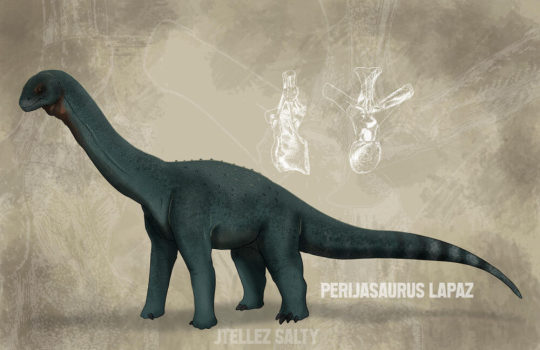#Perijasaurus
Photo

Hi there!
Perijasaurus lapaz from the early jurassic was recently described last month, although it was discovered in 1943, and it’s one of the few dinosaurs found in Colombia
52 notes
·
View notes
Text
Perijasaurus lapaz Rincón et al., 2022 (new genus and species)

(Part of the type vertebra of Perijasaurus lapaz, with broken regions in orange and reconstructed regions or surrounding rock in yellow, from Rincón et al., 2022)
Meaning of name: Perijasaurus = Serranía del Perijá lizard [in Greek]; lapaz = La Paz [town near where the original fossil was discovered]
Age: Early or Middle Jurassic (Toarcian or Aalenian)
Where found: La Quinta Formation, Cesar, Colombia
How much is known: A single back vertebra.
Notes: Perijasaurus was an early sauropod, known from closer to the Equator than any other Early or Middle Jurassic sauropod. The type specimen of this dinosaur had been previously described in 1955, but was left unnamed at the time. Following a reexamination of the fossil, the authors of a new study gave it a name and reinterpreted it in light of what is now known about sauropod diversity. The only known vertebra of Perijasaurus is not as extensively hollow as those of later sauropods, suggesting that it represents an intermediate stage in the evolution of weight-saving features in sauropod vertebrae.
Reference: Rincón, A.F., D.A. Raad Pájaro, H.F. Jiménez Velandia, M.D. Ezcurra, and J.A. Wilson Mantilla. 2022. A sauropod from the Lower Jurassic La Quinta Formation (Dept. Cesar, Colombia) and the initial diversification of eusauropods at low latitudes. Journal of Vertebrate Paleontology advance online publication. doi: 10.1080/02724634.2021.2077112
#Palaeoblr#Dinosaurs#Perijasaurus#Early Jurassic#Middle Jurassic#South America#Sauropoda#2022#Extinct
25 notes
·
View notes
Text

Perijasaurus
Perijasaurus — рід базальних динозаврів-еузавроподів із формації Ла-Квінта департаменту Сезар, північно-східна Колумбія. Типовим видом є Perijasaurus lapaz. Він жив на межі тоарсько-аленського віків приблизно 175 мільйонів років тому від раннього до середнього юрського періоду.
Повний текст на сайті "Вимерлий світ":
https://extinctworld.in.ua/perijasaurus/
#perijasaurus#dinosaur#jurassic#colombia#eusauropoda#dinosaurs#jurassic period#paleoart#perijasaurus lapaz#art#paleontology#animals#prehistory#cretaceous#prehistoric#illustration#daily#extinct#палеоарт#палеонтологія#ukraine#ukrainian#українська мова#арт#україна#мова#тварини#динозавр#колумбія#south america
11 notes
·
View notes
Text
494: A (Very) Long Time Ago
Emily Hart takes us (way) back in time this week, to a very different Colombia - one well before the arrival of human beings… but in the process of looking back, we’ll also be looking forwards - to what the future on this planet might look like.
We have with us some of the team behind "Hace Tiempo" - an incredible book on Colombia’s paleontological past: Colombia’s leading palaeontologist, Carlos Jaramillo, Paleo-botanist at EAFIT University, Camila Martínez, and science communications specialist at Parque Explorer Luz Helena Oviedo.
This illustrated book - now in its second edition - is a paleontological journey through the country’s past, and winner of an Alejandro Ángel prize, one of the most important awards for scientists in Colombia. More than 30 Colombian palaeontologists, working all over the world, contributed to the book, which is available free online – http://repository.humboldt.org.co/handle/20.500.11761/36213 – the physical version is for sale through the website of the Humboldt Institute, a key partner in its creation.
Colombia is enormously fossil-rich and with a huge variety of habitats past and present Understanding Colombia’s ancient flora and fauna is key to understanding the country’s incredible biodiversity today, which is the product of millions of years of evolution, but in the alarmingly short term, is threatened by climate change and the accelerating global extinction of species.
Uniquely, the project also gives readers in Colombia a paleontological resource which relates to the land around them. Rather than the well-known dinosaurs like T-Rex or triceratops, this book presents prehistoric animals peculiar to Colombia, like the 6-tonne giant sloth which lived here 50 million years ago, giant turtles the size of a cars, or the megalodon which roamed Colombia’s waters, the biggest shark to ever exist – bigger than a school bus.
The Titanoboa, meanwhile, was a vast snake weighing over a tonne, which roamed 60 million years ago in the then-tropical jungles of La Guajira, ancestor to the anaconda and the boa constrictor, its body was 13 metres long and – at a cross section - the size of a bicycle wheel. It is the largest snake ever to roam the earth. The Titanoboa was discovered by Carlos himself only a few years ago - after analysing tons of rocks extracted from the Cerrejón mines still active in La Guajira today.
The new and expanded edition of the book - just out - includes a new chapter on Perijasaurus Lapaz, a long-necked herbivorous Colombian dinosaur discovered in 2018 in the Serranía del Perijá. Its name pays homage both to where it was discovered and to the 2016 peace agreement with the FARC, hence lapaz - which allowed palaeontologists to explore that region for the first time in decades.
So today we'll be talking all about what Colombia looked like a very long time ago, what happened since, what fossil records can teach us about climate change, and whether humans are in fact, as Carlos will argue, the least successful species ever to live on Planet Earth.
Check out this episode!
0 notes